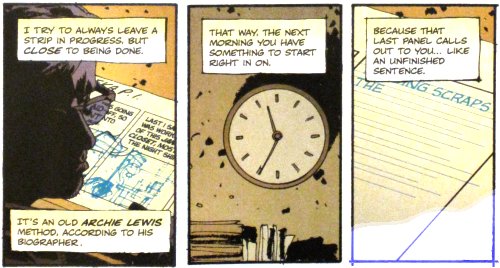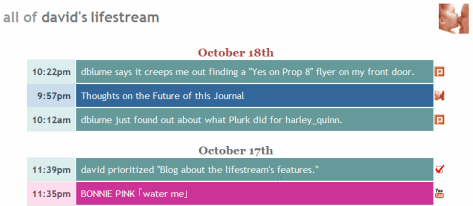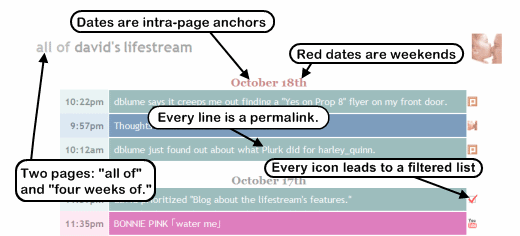Leave the Last Panel Blank
I'm reading Ed Brubaker and Sean Philips's Bad Night. It's the fourth book in their Criminal series of comics. So far, I'm really loving the series and highly recommend it.
Bad Night starts off with the story of a comic strip artist who's evidently about to embark on a bad night. But before he does, he drops this little tip:

That really resonated with me. Before he leaves for the day, he intentionally leaves the last panel undone so that when he returns to work in the morning, he's got a small concrete task calling out to him to be finished.
That's a tactic that would work well with me. If I came in to work with a little unfinished task waiting for me, I'd want to dive right in and finish it. Doing so would have created a bit of "productivity momentum" that moves me right into the next thing I'm supposed to do.
Not only am I reading a world-class comic, but it starts off with a clever and useful productivity tip!
Disclaimer: I tweaked the original four-panel sequence to make it better suit this blog.
Climbing Lesson Number 10
Matthew Childs describes 9 Life Lessons from Rock Climbing:
They're great rules, and anyone can appreciate them. If you really are a rock climber, I think you can appreciate the nuances even better as they apply to each domain. I also think there's a tenth rule.
Rule #10: The first day is for route-finding.
When you go on climbing trips to new destinations, don't get too optimistic about climbing routes as soon as you get there. I think that's an easy pitfall for beginner climbers who are understandably excited to get on the rock. The first time one goes to a new place, getting lost and moving methodically is a part of the experience.
Allocate the time for it. Expect it and plan for it.
If you've set your expectations correctly, then the whole trip is more enjoyable, and it won't feel like a disappointment that you had to do some route-finding on the first day. That first day isn't a loss, it's a part of the preparation for the days of climbing to come, and they'll go more smoothly once you've got the site mapped out.
The same thing applies when going on other adventures in life. You may have a target activity in mind, like enjoying consistent profitability from the residuals of your micro-ISV, but plan on having to do some grunt work to get there. If you're entering uncharted territory, plan on doing a little of your own exploration and mapping.
Father and Son
Aaron and I are looking carefully for turtles at Aweoweo beach on Oahu, Hawaii, where I had just been out there snorkeling with them.
About My Lifestream
I'm really proud of my lifestream. Originally I got the idea from Jeremy Keith. (And I use a subset of his style. I intended to use my own style, but I simply love his, and I don't have any design skill.) A lifestream is an aggregation of your user activity feeds from across the internet. Essentially, it can be thought of as an automatic online diary. It writes itself.

I think I can be thought of as a late early-adapter. I thought I had a lot of original ideas as I made my lifestream, but it turns out that more often than not, somebody else had already implemented one of the ideas. Happily, no one seems to have made all the same decisions as me, so my effort wasn't wasted. For me, my lifestream really is the best lifestream ever! Here's why:

The Best of Both Worlds
Jeremy implements his as an aggregation of RSS and Atom feeds with no persistent storage of previous entries. So, as newer entries are made, the oldest entries are lost forever. His lifestream is always only the most recent few entries. Jeff, on the other hand, implements his with APIs, so he has access to the complete history of entries for any account. I maintain mine with feeds, but I imported my entire history from many accounts. My lifestream is huge, and spans years, even though I just started it a couple of months ago.
Also The Best of Both Worlds
Jeremy's lifestream is handy, because it never becomes unwieldy. It'll always be about the same size. Jeff Croft's and Emily Chang's persist every entry and thus continuously grow. They paginate their lifestream. You can view page 234 out of 399, for example.
I decided that 98% of the time, I'm only interested in something I wrote down in recent memory. Say, the last four weeks. So I made that the index page of my lifestream. Just the 28 most recent days of my online activity. It make for a nice, small page.
But the other 2% of the time, I'm searching for something older, or I'm feeling nostalgic. So I put my entire lifestream on one page, too. Sure, it's big, and I'll never browse it from a phone, but modern web browsers are perfectly capable of downloading it and rendering it, and will be able to do so for years to come. The entire history really has the same appeal to me as being able to search through a diary.
Even if I decide to paginate it eventually, it'll be easy, the backend will facilitate that.
The Details Matter
Since I provide my entire lifestream on one page, I also made sure to include the year for dates that precede this year. (Eg., October 5th, 2006. Note that that uses the intra-page anchor, another important detail.)
My lifestream has a discoverable RSS feed too.

But you know what? Nobody'd want a feed of a lifestream that constantly updates for individual entries. That's one thing that really bothers me about sweetcron feeds. They're just too noisy. Update, update, update!
So the RSS feed for my lifestream only provides weekly updates. That's what I'd really want from a lifestream feed. Just some sort of nice regular overview of all the activity over a certain period of time. And its permalinks are intra-page links into the huge complete history page.
Some of the accounts that I include in my lifestream don't support user activity feeds. For example, YouTube's feed for each user's Favorited videos doesn't have "date-favorited" information associated with it. Since I wrote my own lifestream engine, I was able to work around that problem. I doubt that most lifestream services like FriendFeed would go to the lengths I did in ensuring that I get exactly the information I want, regardless of whether or not the site's feed or API supports it.
It Helps Me Find Things
Searching for things half-remembered turns out to be pretty successful at the lifestream. I sometimes don't know if I posted a link to delicious, or if I plurked it.
It Encourages Me To Write More Clearly
I always think twice before I write a clever title to a tweet, plurk, or blog entry. I realize now that I may well be searching for that entry in the lifestream later, and the lifestream may only have the title. (The lifestream also contains actual content from the entries, but the content isn't presented in the web pages. So maybe the content will be searchable too, eventually.)
Cleverness is out. Accessibility and searchability are in when you have a persistant searchable lifestream. Now, I strive for clarity in my titles.
I also stopped services that cross-post from one service to another. Having the lifestream made the idea of cross-posting even more redundant. If my livejournal friends don't want to see my tweets, I won't force them to with LoudTwitter.
Welcome
This is my personal little spot at dlma.com. At the moment, it's just a portal of sorts.
Since the '90s I've established a few presences on the web. Back then I created a static website. After that, I made a family-oriented blog, a work blog, and I maintained a livejournal account. I never knew what I'd want to do with david.dlma.com though. I've always felt that that particular URL would be reserved for something especially me.
I still don't know what that me will be.
In the meantime, and around this neighborhood, you can find the following things:
- I've got a lifestream. (Its legend and explanation.)
- My old family-oriented blog, My Dilemma.
Here's a little bit more about me.


 Entries
Entries